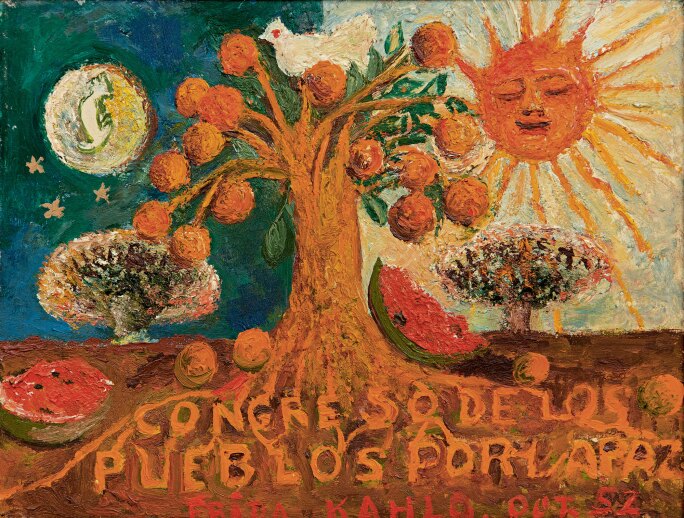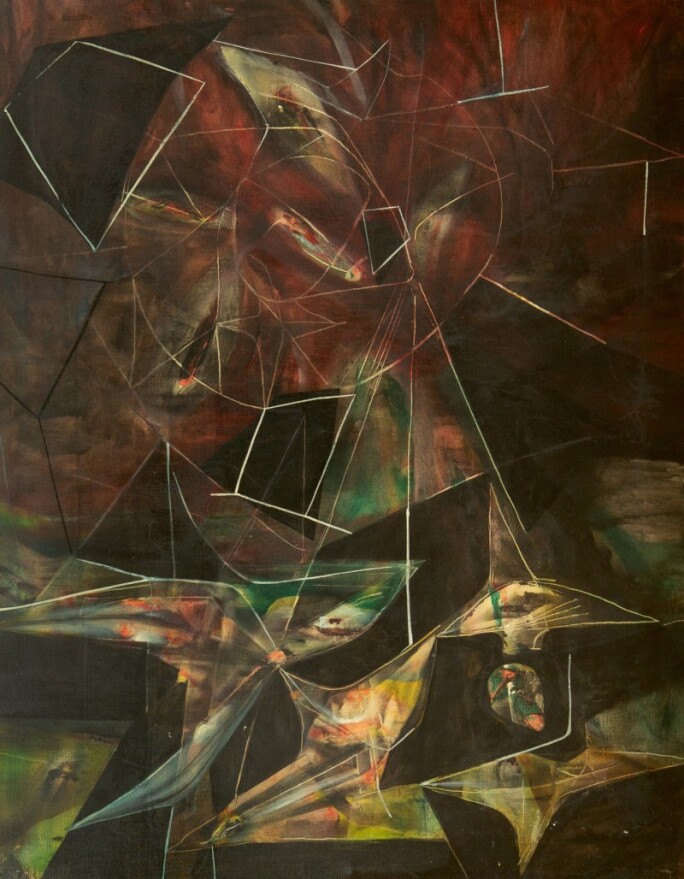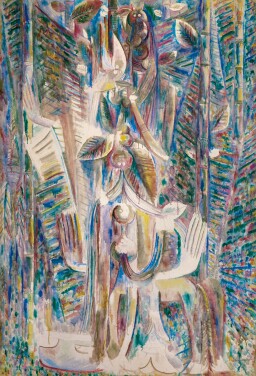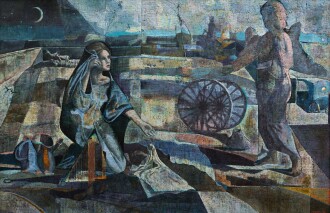"The marvelous is always beautiful. Anything marvelous is beautiful, in fact only the marvelous is beautiful."
T he Vanguard Spirit: Modern and Surrealist Masterworks from an Important Estate encompasses one of the most impressive assemblages of Latin American art in private hands ever offered at auction. Spanning over forty years of enlightened acquisitions, this encyclopedic and intensely personal collection reveals the prescience of a gifted and inquisitive eye—one capable of discerning museum-quality artworks before they were coveted by the collecting world at large.
Anchored in Surrealism by exceptional works by Wifredo Lam, Remedios Varo, Leonora Carrington, Leonor Fini, and Alice Rahon, the collection is complemented by outstanding paintings by two of the most accomplished artists of la vanguardia Cubana: Mario Carreño and Cundo Bermúdez. Archetypal examples by Rufino Tamayo, Frida Kahlo and José Clemente Orozco convey diverse, vital approaches to modernism in Latin America. Largely executed in the mid-twentieth century, a particularly fertile period of cultural activity in Havana and Mexico City, these exemplary works embody the distinct and richly varied plastic vocabulary that evolved throughout the Americas. Portraying local customs and social realities, this remarkable group of iconic paintings is emblematic of the region’s continued pursuit of national identity.
Sotheby’s is honored to offer The Vanguard Spirit: Modern and Surrealist Masterworks from an Important Estate to a global audience of collectors in the context of our marquee sales of Impressionist and Modern and Contemporary Art beginning this summer and throughout 2021.
The following is a selection of artists’ statements and thoughtful reflections published by leading scholars on key works in the collection. Together they reveal the genesis behind individual paintings and cast light on the artists’ unique creative process: their early influences, historical resources, their trans-Atlantic dreams, traumas, and lost loves. Altogether, they allow for a closer appreciation of the incredibly complex web that connects their body of work to their personal biographies.
Wifredo Lam
“And it is to be a painter from the Americas, the Cuban Wifredo Lam, to show us the magic of tropical vegetation, the unbridled Creation of Forms of our natural world, with all its metamorphoses and symbioses, in monumental canvases of expressiveness unique in contemporary painting.”
–Alejo Carpentier, 1987
“The extraordinary paintings that he [Wifredo Lam] made between 1942 and 1943, among them Omi Obini and the paradigmatic Jungle, distill the creative syncretism of his practice, commingling modernism and magic in myriad recombinant forms. Among the most iconic works of global modernism, Lam’s compositions from these Cuban years subsume New World cosmologies within numinous, hybrid figures—plant, human, divine—that play out a vivid drama of transculturation.”
–Dr. Abigail McEwen
“As seen in Omi Obini and Ogue Orisa, occasionally the balance between the two elements tips in favor of the landscape and the fusion between plant and human is even more seamless than in The Jungle,” observes the noted Lam scholar, Lowery Stokes Sims. “Lam also used a ‘pointillist’ style to achieve a visual integration between figure and ground in the continuous repetition of separate daubs or strokes of varicolored paint, effectively visualiz[ing] the permeability between the physical and metaphysical worlds.” In some cases, “still-life elements are literally left white and surrounded by stippling as if they were stenciled onto the canvas,” a technique that “conveys the visual experience of the brilliant, reflective light of the Caribbean. In works such as Omi Obini and Ogue Orisa the forms as a result seem to flicker in and out of view, reinforcing the sense of a tenuous boundary between the physical and metaphysical.”
–Lowery Stokes Sims (Wifredo Lam and the International Avant-Garde, 1923-1982, Austin, 2002, pp. 47-50)
“She is the river […] Omí Obiní, woman of water, she is the Lady of Fresh Waters who fertilizes the earth and dances, dispensing life. She slips and slides among the reeds, alongside the flanks of the bodies that rock and sway, transported by the miraculous rhythm of the wave; and her shining arms and knowing hips undulate in time with the water. Her long wake is frothy; the merry water breaks, boils, and splashes back against her starched petticoats. Her body gleams with springs and currents.”
–Lydia Cabrera (“El chivo hiede,” in Por qué…cuentos negros de Cuba, Madrid, 1972, p. 48.
“Mexico has the good fortune that among us live three women painters who undoubtedly are among the most important women artists in the world: Remedios Varo, Leonora Carrington and Alice Rahon.”
–Diego Rivera
Remedios Varo
“In refusing the position of femme enfant and femme fatale, goddess and muse offered by Surrealist theory (mostly developed while the women were absent), Varo chartered a new course of self-empowerment and self-discovery.
–Janet Kaplan (Remedios Varo: Catálogo Razonado, Mexico City, 2002, p. 34)
“Among Varo’s contributions to Surrealism was a new vision of creativity with a woman as active subject rather than passive object or catalytic muse for someone else’s creativity. She offered an alternative iconography specifically counter to traditional male-defined surrealist theory in which the revolutionary power of Eros uses Woman as a conduit for Man. Varo’s work, instead, is based on a woman’s psychology and experiences in which her access to the marvelous relies on the self as active agent without need of erotic displacement.”
–Janet Kaplan (Remedios Varo: Catálogo Razonado, Mexico City, 2002, p. 37)
“This person is trying to find the invisible thread that unites all things; so, on a musical staff made of metal threads he places all sorts of objects ranging from the simplest to a small piece of paper containing a mathematical formula which, per se, means a whole lot of things. Once he manages to put all these different objects into place, by blowing air through the clef supporting the staff, he should produce music that is not only harmonious, but also objective, i.e., capable of moving the things around it if that is the intention of the player. The figure coming out of the wall, which helps him, represents chance (a factor that comes into play so often in all discoveries), but objective chance. I use the word “objective” to refer to the fact that it is something outside our world, that is to say, beyond it, and that it is connected to the world of causes, rather than to ours, which is a world of phenomena.”
–Remedios Varo
Alice Rahon
The Surrealists strongly believed in the spiritual power of nature. The magnificent topography and fantastic volcanoes that they beheld in Mexico inspired many of their creations. Rahon was perhaps the Surrealist who most frequently depicted the Mexican natural landscape. In numerous paintings, her poetic images reference her travels to different corners of the country; they depict mountains, volcanoes, lakes, rivers, oceans, deserts and starlit skies...Her canvases portray a dynamism of ancient energies, colorful images, powerful myths and magical places.”
–Tere Arcq (Alice Rahon, Poetic Invocations, Miami, 2019, n.p.)
Mario Carreño
Mario Carreño is “the most versatile, learned, and courageous of the new generation,” naming the “heroic” Cortadores de caña “among the most ambitious and powerful compositions in Cuban painting.”
–Alfred H. Barr, Founding Director, the Museum of Modern Art (Modern Cuban Painters,” Museum of Modern Art Bulletin XI, no. 5, April 1944, pp. 4-5)
“With Duco he cannot obtain subtle color saturations. He uses it in a superimposition of successive layers.” Not unlike the young Jackson Pollock, who had earlier studied with Siqueiros in New York, Carreño made “full use of the ‘accidents’ that result from the fast-drying nature of this medium…, producing spectacular efforts by his skillful handling of its irregular, crusty surface.”
–José Gómez Sicre (Carreño, Havana, 1943, n.p.)
Leonora Carrington
“Play reigns in Leonora Carrington’s universe imposing its rules that aim at the increase of pleasure and at its continuous renewal. It is this play—one of the most dangerous—that has allowed her to enter the subterranean world where, she says, one can enter and exit at will. Is it therefore this ambition that gives her paintings their very considerable character of intrigue and exorcism? In any case, this character dominates everything she creates.”
–Benjamin Perét (“Le jeu de Leonora Carrington,” July 1952)
Leonor Fini
Painted in 1938, Figures on a Terrace embodies Fini’s painterly vision. As Peter Webb observes, the late 1930s were a key period for Fini: “These [1938-39] paintings mark an important stage in the progress of Leonor’s art. They demonstrate not only the lessons she learned from Surrealism but also her independence from the movement. They create an erotic dream world in which women are in control, a world that would become characteristic of so many of her later images” (P. Webb, op. cit., p. 77). In Figures on a Terrace the dominance of the female figure in the foreground makes its clear that this is a world in which women reign; indeed the ambiguous setting implies a new world order. While the precise stylization and restrained palette recalls the Mannerist art that Fini so admired, the proscenium terrace that provides the backdrop for her "drama" is a reminder of her extensive work designing stage sets and costumes. She creates a marvelous, unsettling contrast between the languid attitude of the figures and the definite, underlying erotic tension that pervades the work.
Frida Kahlo
Congreso de los pueblos por la Paz was painted by Kahlo in the fall of 1952, when her health was in an especially delicate state and painting presented a particular challenge. However, she found the necessary encouragement in her ideological struggles, and painted the work with the conviction to participate in the Peoples for Peace Congress to be held in Vienna that year, intending to attend alongside Diego Rivera and his daughter Ruth. The small painting has an unusual expressionism due to its acidic chromatic tones and Kahlo’s playful, gestural brushstrokes….As in a Dante-esque vision, Kahlo imagines the horror of a nuclear apocalypse; two explosions materialize at the horizon of the landscape, rising in a fiery cloud, destroying all traces of civilization. In the foreground, Kahlo plants as defense a tree of truth and life, with its fruits of knowledge as a message of hope for humanity... Likewise even in the most difficult moments of her time on earth, Frida Kahlo made painting a reason to continue living.
–Professor Luis-Martín Lozano, Art Historian
Matta
Painted at a new apex in Matta’s critical and commercial popularity between 1940-1944 in New York, Galaxies (Mysticism of Infinity) is a paragon of this fertile period in the artist’s production. As many of the European Surrealists fled the continent at the outbreak of the second world war, Matta, one of the youngest of the group, found in New York a critical ground of inspiration – both in the Europeans in exile, and in the burgeoning New York School. His strikingly atmospheric psychological morphologies of these years, marked by acidic fields of color and a dematerialization of the linear geometry that had obsessed earlier modern artists – as well as his “absolute irreverence, witty iconoclasm, predilection for plays on words, as well as his interest in alchemy and the occult” (Martica Sawin, Surrealism in Exile, p. 318) led him to quickly become a darling of New York’s critics and collectors during the war years









































